
Samvatsara Katha by Chidakaash Kalalaya
- Nita Vidyarthi
e-mail: nitavidyarthi@gmail.com
Photos courtesy: Chidakaash Kalalaya
June 8, 2019
Among those who have moved to study Natyashastra tradition of Natya
(drama) practices and its applications during the past decade to the end
of reconstructing them, no one is more fortunately equipped for the
task than its scholar and Guru Piyal Bhattacharya, who has seriously
applied himself to the subject. He is at once a dancer, musician,
dramatist, writer and choreographer engaged in elucidating the core
worldview and its subsequent efflorescence through various dramatization
of selective texts.
Rupaka is the Sanskrit word for drama and follows the Natyashastra
strictly. Piyal's present focus is on Upa-rupakas which were developed
in the post Natyashastra period. They do follow Shastraic grammar but
the structures of these ancient dramas can be altered and improvised
within the boundary of the Natyashastra.
Slide show
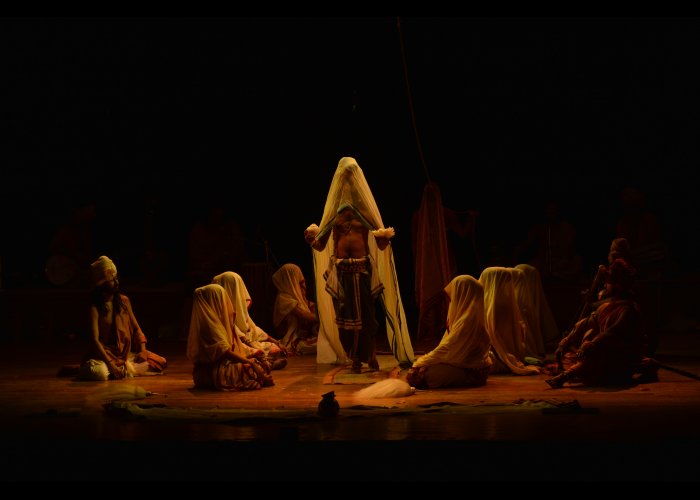
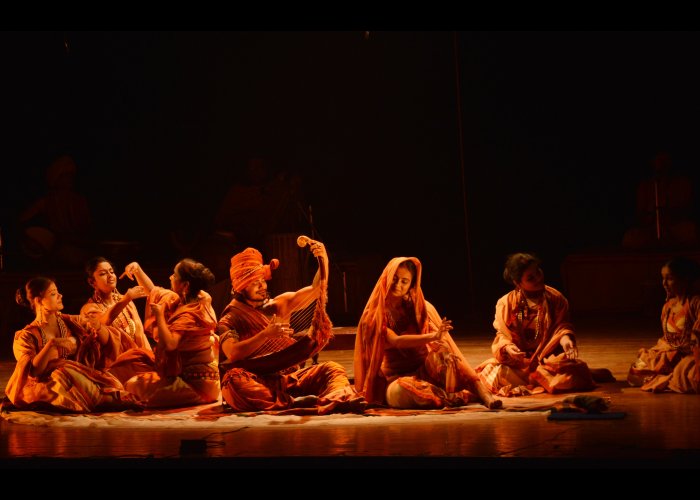
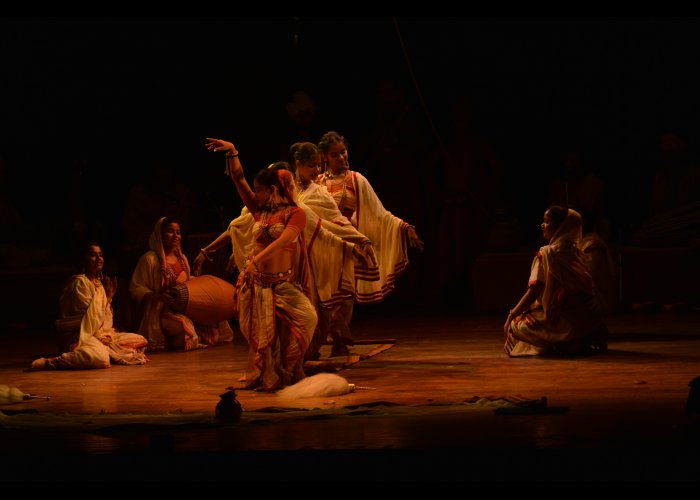
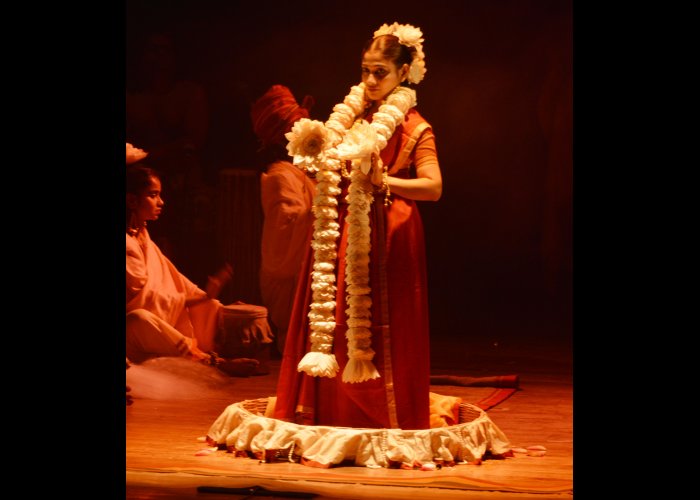
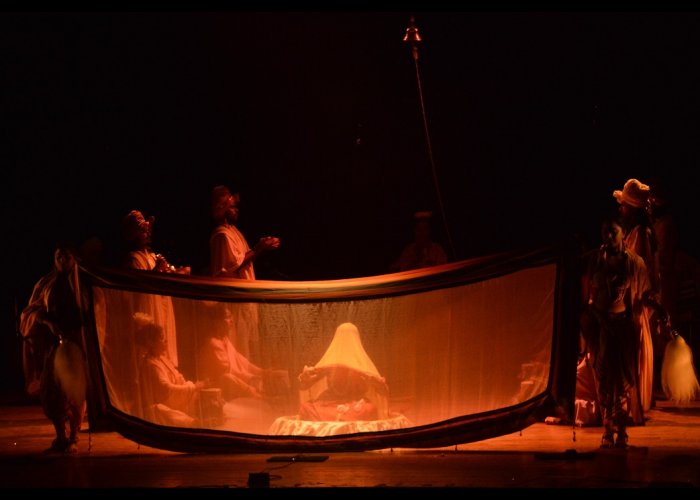
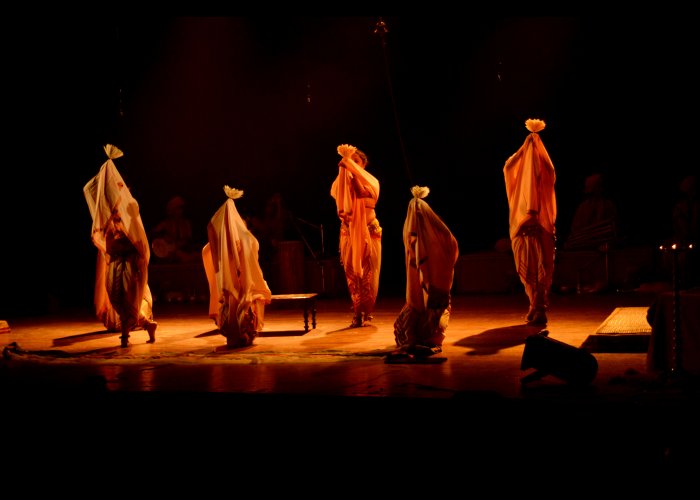
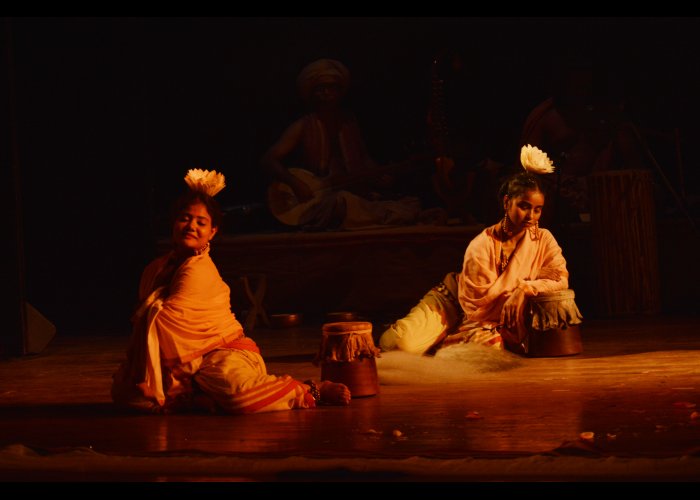
The spectacular Upa-rupaka 'Samvatsara Katha' by the artists of
Chidakaash Kalalaya, The Centre for Art and Divinity, spearheaded by
Piyal was recently staged at Uttam Manch and in quick succession at
Tapan Theatre, Kolkata. Conceived, choreographed and directed by him,
the production was principally the description pertaining to seasonal
manifestations known as Ramkreeda. In order to explore the poetic
liberations, Piyal reconstructed this Upa-rupaka, a minor dramatic form
developed post Bharata Muni's era, by incorporating two others, Prerana
(an enigmatic, yet humorous representation, strung with riddles) and
Hallisaka (dance performed in circles) in the performance. It concerns
the formation of seasons or Ritu and emerged out of the training
received by his disciples on 'Marga Natya' based on his research. The
production tried to bridge the gap between academic work and the
practical execution of this tradition making it suitable and acceptable
in the present time.
Woven around Bhrgu or cosmic male epitomising Agni (formless
energy) and Angira or cosmic female epitomising Soma (formless matter),
their characteristic subtleties were expressed through the myriad forms
of beings and phenomena. The Ritu-Chakra or change of seasons in the
Indian context is one such physical creativity of nature.
With the musicians seated at the back of the stage, the
Mangalacharan ushered in the invocation of 'Samvatsara Chakra'
from Satapatha Brahmana Vijnanabhasya by Pt. Madhusudan Ojha and Pt.
Motilal Shastri. With only a spotlight projected to the center stage,
Bhrgu (stately Sayak Mitra) adorned with a garland of bells around his
body comes in a veil, followed by Angira (Rinky Mondal), who is not
fully revealed, suggesting that truth always remain shrouded. This
depicted adi rasa (shringar) and adi raga respectively. The arrival of
each ritu was elucidated by a masculine entity wrapped in royal grandeur
and feminine entity as the Nature's delightful desire to succumb to its
enigma.
The performance text was based mainly on Kalidasa's Ritusamhara, Magh's
Sisupalavadha's sixth canto and Jayadeva's Gita Govinda apart from
inputs from Sudraka's Padmapabhritakam and Jaiminiya Upanishad. The
music was an integral part of the reconstruction process. A meticulously
trained Dhrupad singer, Piyal structured the Dhrupad songs under
specific ragas to provide visual imagery of the different ritus. There
was no recorded music and the "padas" of the songs picturised the
different season. A combination of ancient and medieval instruments like
singa (buffalo horn), conch shell, shehnai and chitra vina set the tone
of this work of reconstruction. Dhrupadi Rabab was specially used to
add colour to the production.
The colour of the costumes was influenced by the Ragamala paintings of
the late 16th to early 18th century from different regions of Rajasthan,
Deccan and Nepal. The attires and the exotic ornaments, all made by the
members of the organisation were not only stunning but transports the
audience to the medieval Indian era.
Rudra Prasad Roy with his stout, sculpted physique fitted the first
ritu, Grisma (summer) perfectly as he entered with bold steps set to the
striking notes of Brindavani Saranga in the Khayal "Dahan lagey Suraj
Kiran". Strumming of straight notes from Mattakokila Vina (21 strings)
represented sharp, burning heat. The Vipanchi Vina (9 strings) played by
young minstrel, serenading beautiful women represented the intoxicating
heat, complementing the burning summer.
A sight to behold was Meghraj (Sayak) arriving with his Kinnari Vina
accompanying the thundering "gong gong Ganapati." His elephantine
movements sprinkled with "Ashani shabda mardala" from Kalidasa's
Ritusamhara, "Nupurnaad ramya" and "Jhamjham brishti" depicting monsoon
clouds, sways with legs raised sideways while gradually lifting the foot
with toe upwards were some fine points in the choreography executed
marvellously by a dancer of high calibre. Raga Megh, percussion
instruments like mridangam, pakhawaj, mizhavu and mainly Bengal
srikhol played by a group of women covered under an indigo Jamdani
symbolizing the rumbling clouds articulated the tone of Varsha
(monsoon).
The arrival of Sarat (autumn) with the chanting of slokas from
Ritusamhara in Akashbhasita on the raga Revathi/Vairagi was enacted by a
group of women (Prakriti) dancers with Angadhvani. Women dancers with
white pith lotuses pinned on the top of their heads offered a wonderful
imagery of the flowers floating in the ponds and the white stoles on
them symbolized purity. The Devi arrived with the sonorous selection of
Devisukta along with all the Mangal Vadya - Kutti mizhavu, bells of
Kumbakonam, cymbals, kurangkural/shehnai, mizhavu, mridangam and
srikhol, to create an auspicious ambience .The only scene behind the
curtain (Antarayavanika) was the "Nirmalya," an offering to Adishakti by
the divine trinity Brahma, Vishnu and Maheshwar.
Hemanta, the transitional ritu, harbinger of winter was depicted by raga
Bihag suggestive of the depressive feeling for the estranged lover.
Raga Bihag is mentioned in Sangita Parijat as raga Bihangam. Hemanta
wraps nature with a bleak cover - the white stoles symbolize the onset
of winter. Slokas from Ritusamhara painted the harvesting season. Winter
or Sit was ordinary as compared to the other seasons. It was portrayed
from Sudraka's Padmapabhritakam by Sayak Mitra.
Raga Vasanta heralded Spring (Vasanta) with joyous celebration by
blending dance and evoking images of happiness through Jayadeva's
"Lalita Lavangalata" and enacting verses from Kalidasa's Ritusamhara
worshipping Kamadeva (Deep Ghosh) seated under the canopy of his
Ekatantri Vina. Sringar rasa is the dominant rasa of Vasanta depicted by
adi vina: Ekatantri Vina (one stringed tube zither) as seen in the
Ragamala paintings. An enchanting irresistible swinging rendition of
"Naba palasha palasha, banampurasphuta paragaparaga" developed the
merriment and ecstasy of Vasanta.
The gratifying presentation ended with the ultimate bliss where the
dichotomy of Bhrgu and Angira, ritu and nature ceased to exist revealing
oneness. The dancers were covered with veils which signify the diluted
existence of Bhrgu and Angira as separate entities, which faded away to
ultimate bliss with the chanting of 'Narayana...'
A thundering applause from the audience and words of appreciation from
the legendary Ratan Thiyam who watched the performance eagerly, for
Piyal and his work and courage to present such productions made
'Samvatsara Katha' worthwhile.
Dr. Nita Vidyarthi is a veteran critic of performing arts and writes on dance, music and theatre in leading publications.
|





